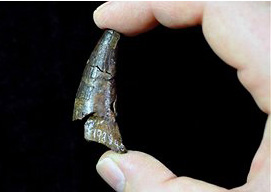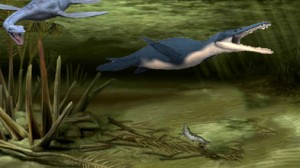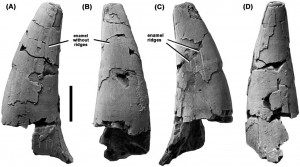Freshwater Pliosaur from Cretaceous Victoria
Fossil Tooth Provides Evidence of an Australian Freshwater Pliosaur
When amateur palaeontologist Mike Cleeland found a fossilised tooth whilst exploring an area close to San Remo for dinosaur bones, he did not think at the time that his fossil find would lead to new insights into the lifestyles and habits of sea monsters.
Freshwater Pliosaur
Thanks to a joint investigation by scientists from Museum Victoria, Monash University (Australia) and Oxford University (England), palaeontologists have evidence of a giant, freshwater pliosaur. The discovery suggests that both short-necked and long-necked plesiosaurs lived in freshwater for at least some parts of their lives. Perhaps, like some species of extant cetaceans such as the river dolphins of the Amazon Basin and the Ganges in India, these reptiles lived their entire lives in freshwater and they had adapted to a life in rivers and estuaries.
The tooth measures approximately 45 millimetres in length and it was found in 1994, in an area around fifty miles from the centre of Melbourne (Victoria). The strata in which the fossil was found represents a 100-million-year-old river system. During the Cretaceous, this part of Australia was a low-lying plain which was crossed by many meandering, large rivers.
Not a Crocodile Tooth
At first the tooth was thought to belong to a particularly big crocodile, as fossils of Cretaceous crocodilians had been found in the area in the past, but the tooth was not intensively studied until a couple of years ago when Dr Erich Fitzgerald (Senior Curator of Vertebrate Palaeontology a Museum Victoria), decided to take a closer look at the specimen.
Under the microscope, a series of ridges in the preserved enamel could be seen. The ridges, essentially a series of fine lines, are spaced apart from each other and stop short of the crown apex (the top of the tooth). This ridge pattern differs from that seen on smaller teeth found in the same locality. The smaller teeth measure between 10 and 20 millimetres in size and possess ridges that are closer together and continue closer to the apex of the crown (the tip of the tooth).
Dr Fitzgerald suspected that Mike Cleeland’s fossil tooth could be that of a freshwater pliosaur, but he consulted Dr Roger Benson (Oxford University), who was in Melbourne at the time studying dinosaur fossils that had been discovered in the area. Dr Benson had studied a number of pliosaur fossils that had been found in England and he was able to confirm Dr Fitzgerald’s initial view that this large tooth was indeed that of a pliosaur.
The Thumb-sized Tooth of the Freshwater Pliosaur
Picture credit: Museum Victoria
Establishing the Evidence
Thus began the long, painstaking process to establish a body of evidence to suggest that this was a freshwater pliosaur tooth. The matrix from which the tooth was extracted was examined, other fossils found in the location were studied and an examination of the palaeo-environment undertaken. The research team have concluded that the tooth was from a five-metre-long pliosaur, a predator that used to live in the waterways that once criss-crossed this part of Australia.
Scientists had found evidence of a smaller, plesiosaur, a long-necked plesiosaur living in the same ancient river system. This is the first evidence of a large pliosaur sharing rivers with another member of the Plesiosauria.
An Illustration showing Types of Plesiosaur in a Freshwater Environment
Picture credit: Everything Dinosaur/M. Witton/Lyme Regis
Marine Reptiles – A Contradiction
The picture above is a composite made by Everything Dinosaur team members based on an image of a Pliosaur produced by renowned artist Mark Witton and the image of a plesiosaur from Lyme Regis museum. The picture shows a scene in the freshwater environment of Cretaceous Australia where plesiosaurs and pliosaurs shared the same eco-system.
Commenting upon the differences between short-necked plesiosaurs and long-necked plesiosaurs, Dr Fitzgerald stated:
“The Plesiosauria include all those sea-going reptiles from the age of dinosaurs that have these very long snake-like necks and they’ve often been used as a model for the mythological Loch Ness Monster. The pliosaur is a shorter-necked, much more robust and crocodile-headed relative of those long-necked plesiosaurs.”
The palaeontologist confirmed that the plesiosaur had much smaller teeth which revealed information about the diet of the now extinct species.
“What we can tell from studying the teeth of these river reptiles is that the smaller species was feeding on relatively small prey. If you have smaller, finer, needle-like teeth, you’re much more likely to be using your teeth as a fishtrap to catch small fish.”
Feeding on Much Larger Animals
However, the much larger teeth of the pliosaur indicate that it was feeding on much larger animals, perhaps bigger types of fish, the plesiosaurs themselves, crocodiles or even small dinosaurs as they came down to the riverbank to get a drink.
A Close up of the Pliosaur Tooth Showing the Fine Ridges
Picture credit: Museum Victoria/M. Benson
This is the first evidence to suggest that two Plesiosauria lived inland together at the same time, in the same river system. Recently, a team of scientists studying a Late Cretaceous mosasaur fossil found in Hungary have concluded that mosasaurs too, had members of their group that also lived in freshwater.
To read more about the mosasaur research: Freshwater Mosasaur from a Hungarian Bauxite Mine.
It seems that the term marine reptiles, when applied to the Plesiosauria and even the mosasaurs may not be technically accurate anymore.




